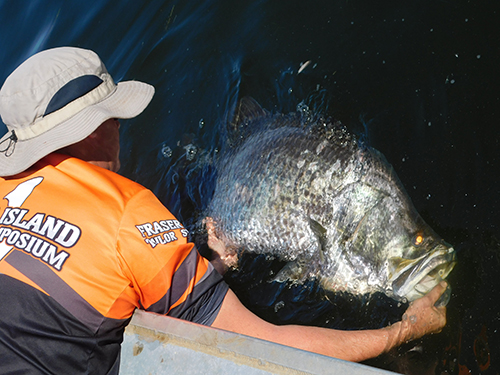Recreational fishers may be pleased to know that Barramundi that spend time in fresh water as juveniles grow faster and larger than those that spend their entire lives in salt water.
That is one of the findings of a research project that found that more than a third of adult Barramundi in Queensland's north-east coast spend their 'teenage' years in fresh water.

The project to identify the origin of legal-size Barramundi, was funded by Fisheries Research and Development Corporation (FRDC) and the Queensland Department of Agriculture and Fisheries (DAF) and carried out by a team of scientists from DAF, James Cook University and the University of Western Australia.
Researchers analysed otoliths – fish ear bones that grow rings every year (much like trees) – to learn where Barramundi had lived at distinct stages of their lives.
DAF senior scientist Dr Susannah Leahy said 33 per cent of barramundi caught in the Townsville and Burdekin marine fishery had spent at least one year in fresh water as juveniles.
‘Born in salt water, these fish made their way upstream to freshwater lagoons during wet seasons,’ she said
‘They grew significantly faster and larger than fish that stayed in salt water their entire lives.
‘This research highlights the importance of healthy freshwater habitats and fishways enabling Barramundi to travel upstream.’
‘Our work shows that the biggest benefit to the wild Barramundi population comes from juvenile fish getting access to healthy freshwater habitats.’
FRDC Managing Director Dr Patrick Hone said that the project achieved more than its original objective, which was to identify the best methods for distinguishing between wild origin and hatchery origin Barramundi to support quantitative stock assessments.
‘At least four million Barramundi fingerlings have been released into impounded waterways, coastal lagoons, rivers and estuaries in Queensland since 2010. This research confirms that, when these stocked Barramundi escape over impoundment walls (for example, during flooding), they reproduce with wild Barramundi thereby mixing their genetic material into subsequent generations. This mingling of wild and stocked Barramundi highlights the importance of fish stocking regulations to support local genetic diversity.
‘These findings will be of interest to Barramundi fishers in all parts of Australia given Barramundi’s widespread popularity with recreational and commercial fishers.
Dr Leahy thanked the Townsville Barramundi Restocking Group, Burdekin Fish Restocking Association, Cungulla Recreational Fishing and Social Club and participating aquaculture facilities for their assistance.
FRDC Project 2018-047 Barramundi origins: determining the contribution of stocking to the Barramundi catch on Queensland's east coast.





